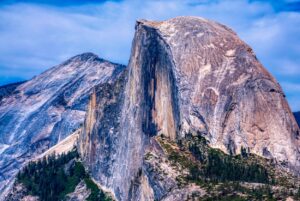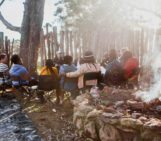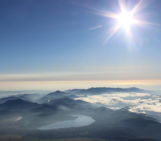
This month for GeoTalk we were lucky enough to speak with Anjana Khatwa, the author of a new geoscience book ‘The Whispers of Rock’. Dr Anjana Khatwa is an award-winning Earth Scientist, science communicator, writer, presenter and advocate for diversity in natural heritage spaces. For over twenty years, Anjana has worked as a learning and engagement professional in the natural heritage sector on the Jurassic Coast of the UK, helping people of all backgrounds connect with the landscapes around them. Her recently published book, ’The Whispers of Rock’ shares the way that geoscientists see so much more than just the current landscape when they look at a rock, as the rocks themselves whisper their secrets to those who listen closely.
Hi Anjana, thank you so much for speaking with us today! You mention at the start of ‘The Whispers of Rock’ the way that “the geological world is almost continuously excluded from conversations which discuss the meaning and value of nature in our lives”. What inspired you to write this book as an antithesis of that exclusion, weaving human experiences with geological scientific information throughout?
With over 25 years working in protected landscape conservation, I have led multiple public engagement and learning programmes that attempt to bring stunning geological landscapes to life for people from all backgrounds. I have found that although geology can create a sense of awe and wonder through its stories of deep time and visual beauty, many people find this aspect of the natural world too complex and abstract to welcome into their everyday lives as they might do a beloved tree or a bird that visits their garden each day. Part of the problem is that rock exists in such a ubiquitous state that we almost don’t see it anymore – it is invisible even in plain sight. When we also consider that geological change occurs at such vast timescales and in places beyond our comprehension, it is no surprise that their existence and meaning to our lives has been overlooked.
Since the pandemic, I have noted how there has been an urgent call for society to ‘reconnect’ with nature but very rarely has the geological world been factored into these narratives. Despite being the fundamental basis upon which all life systems depend, our emotional engagement with rock in the western world remains cold and distant. It’s worth is measured through what it can provide through economic means rather than through personal or spiritual nourishment.
To counter this narrative, I went in search of how ancient knowledge systems (including from my own South Asian culture) could help to reframe our relationship with rock. As I drew together Indigenous stories from across the world, there was one common factor that ensured these cultures retained a sense of reverence and connection with rock and landscape – love. This powerful emotion that many scientists may dismiss as romantic idealism has instead ensured that a sense of custodianship guides the conservation and care of some of the most significant geological landscape in the world. In The Whispers of Rock, I explore how this sense of love and care for the geological world can in fact foster a deeper and more personal relationship with the rocks around you. If we accept rock as ancient knowledge keepers of our life experiences along with that of memorialising earth’s history, we imbue them with life and meaning so that they become an animate part of the world we live in.
Throughout ‘The Whispers of Rock’ you share stories and perspectives from all over the world, including the cultural and spiritual importance of the basaltic statue Hoa Hakananai’a from Rapa Nui (formerly Easter Island), the mineralogy of coffee in Kenya and Eritrea, and the mythology that surrounds the erratic boulder, Kummakivi, in Finland. Which story is your favourite?

Tis-se-yak (also known as Half Dome). Photo credit: Teamrat Ghezzehei on imaggeo.egu.eu
The stories that resonated with me the most perhaps speak to my own childhood of being raised to see the natural world and especially rock through a lens of humility and grace. I found the Ahwahneechee story of Tis-se-yak (known in English as Half Dome), a granitic peak that towers over the valley in Yosemite National Park, especially moving. The story tells of a husband and wife travelling through the valley who become increasingly agitated by their desperate need for food and water. Walking ahead of her husband, the woman discovers a lake and dips her head to the water and drinks the lake dry. When her husband arrives, he is furious that she has left him no water to drink and he reaches out for his stick to strike her. Appalled by his intent, the woman runs away with tears streaming down her face and in her anger she throws her basket at him. The Great Spirit is angered as he watches this debacle unfold and as a lesson to humanity, he turns each of them into towers of rock that border the valley. The woman becomes Tis-se-yak and her tears are immortalised on the rock as black streaks that scientists know as lichen.
What is especially profound about this story is how it has provided a sense of connection for Miwuk First Nations whose ancestors were dispossessed of their ancestral lands that incorporated Yosemite Valley. The rock not only grounds them in memory, time and place but it provides a sense of spiritual connection to their ancestors. It provides an opportunity to seek humility whilst reflecting on the grandeur of nature and I feel that we could all benefit from embracing stories such as these.
In the last chapter, you talk about how other ways of knowing and spirituality are not actually the denial of geoscience that they can often be framed as and instead represent a more inclusive way to approach Earth Science. What advice do you have for anyone who is curious about exploring this more holistic way to view our subject?
To enter this space that presents a diverse perspective on how humans have experienced the world requires embracing a sense of humility and empathy. Western science is rooted in empiricism which has necessarily required the participant to observe and evaluate natural phenomena at the expense of personal feeling and emotion. Although we have seen great progress through scientific endeavours delivered through this approach, it has also generated incalculable harm and impact through the extraction, exploitation and subjugation of people and nature itself. Through accepting that other belief systems hold equitable value and position alongside that of western science, you can transition into a space of tolerance, care and ethical practice. Guided by wisdom that has been crafted over tens of thousands of years offers rich insight into how we can begin to tackle some of the problems that science has created such as climate change and habitat destruction. Indigenous Knowledge and cultural wisdom is not a silver bullet to solve the problems of the world, but alongside western science it provides a strong ethical framework on which to base research and thinking for a more sustainable future.
Lastly, you mention going on so many wonderful sounding walks, both to centre yourself in nature and explore the geological world around you, what is your favourite walk that you took whilst writing this book?
Walking in the outdoors has always been a huge part of my life. Partly it was a source of mental health recovery after my first husband left me and my daughter but it also gives me a sense of joy to be close to rocks in their natural state. Researching the book took me all over the world in search of experiences that would add substance to my writing, and walking in nature was a key part of that process. Some of my favourite walks are when I can really feel the stories of the rocks through how they are presented in the natural environment. I can be in a coffee shop in the middle of London gazing at ammonites on a limestone floor or in a quarry where the stark rock faces speak to me of human hands cleaving away at their surface.
Perhaps the most profound walk where I felt the whispers of rock to be at their most powerful was along the Eryri (Snowdonia) Slate Trail that borders the immense chasm that is Penrhyn Quarry in North Wales. As you walk along the path, the rock transitions from tall walls of imposing grey slate to vast piles of discarded rock. Although you can hear the river rushing below you in the valley, it is the angular slate blocks that unashamedly demand your attention. Haphazardly piled along the trail, these vast quantities of slate represent an era of mass consumption when slate was used to tile the roofs of factories and houses during the industrial revolution. As the walk opens into a beautiful Welsh valley, the starkness of the waste rock begins to soften by nature taking back what was discarded by people. This is a walk that not only connects you to the raw beauty of rock but it also helps you to contemplate our relationship with it.
Find Anjana’s book, ‘The Whispers of Rock’ here.
Interview by Hazel Gibson, EGU Head of Communications





